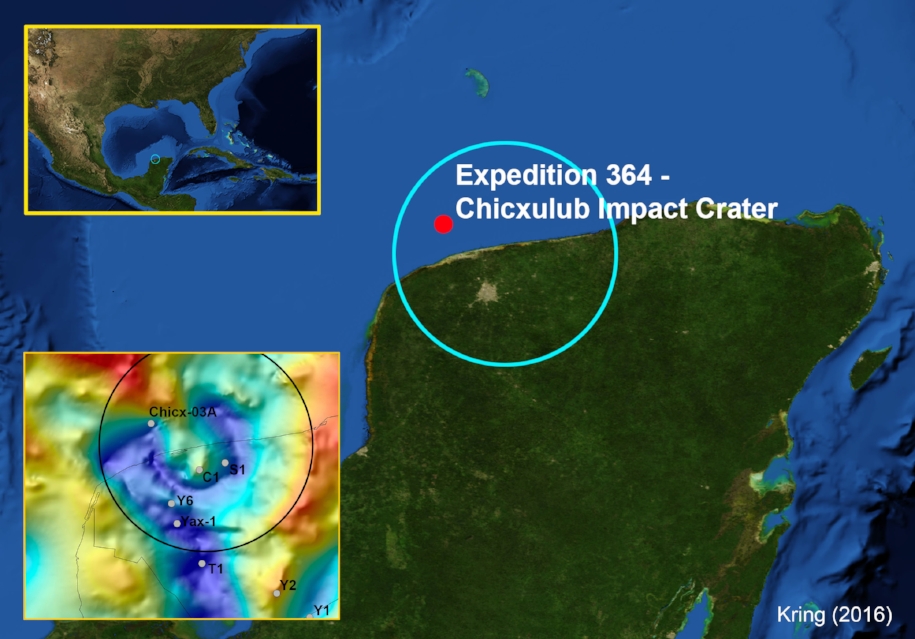Kevin Kurtz
Children's Author & Educator
The Chicxulub K-Pg Impact Crater Expedition
Sixty-six million years ago, a huge asteroid struck what is now the Gulf of Mexico.
The asteroid was so big and moving so fast that it set off a catastrophic explosion. It left behind a crater that was over 110 miles wide. The impact was the beginning of the end for over 75% of the species on Earth, including most dinosaurs.
Sixty-six million years later, in the spring of 2016, scientists went to the Gulf of Mexico to drill into the crater. They wanted to bring up rocks that might provide clues about what happened during and after the asteroid impact. For two months, the ship drilled deep into the crater to collect cores of rock. The cores were then shipped to a science lab in Germany. In the fall of 2016, about thirty scientists came together to study the core samples from the crater and see what secrets they revealed.
Kevin had the amazing opportunity to join the expedition scientists in both the Gulf of Mexico and in Germany and share in and write about this incredible experience.
So what was the expedition all about?
The impact crater is called the Chicxulub Crater (“Chicxulub” is pronounced ‘chick-shoe-lube'). It is called that because ground zero for the asteroid impact is at what is now the town of Chicxulub, which is on the Yucatan Peninsula in Mexico.
Today, about half the Chicxulub Crater is found on land on the Yucatan Peninsula and half is underwater in the Gulf of Mexico (the crater's location fills the blue circle on the map above).
Over 66 million years, the crater was completely buried and hidden under the ground. No one knew the crater was there until it was discovered in 1978. It wasn't until 1990 that scientists realized this was the crater from the asteroid impact that wiped out the dinosaurs.
The colorful image in the corner is basically like an x-ray of the Earth. It shows what the crater looks like underground.
The Chicxulub K-Pg Impact Crater Expedition was the first time anyone had drilled into the crater from sea. It can take a lot of time to plan and raise the money for a scientific research expedition. That’s why it took twenty-six years from the time scientists found the smoking gun for the dinosaur extinction until they drilled into it to study it.
The expedition science team drilled into the crater at a place roughly due south of New Orleans. The drilling site is off the coast of the Yucatan Peninsula in Mexico, near the town of Progreso. It's the red dot on the map above.
Drilling occurred on the Liftboat Myrtle, a surreal-looking ship that use stilts to stand on the seafloor and lift itself above the water. It does this to prevent waves from rocking it back and forth, which makes drilling a lot easier.
The Liftboat Myrtle is not normally a drill ship, but a drill was welded and pinned to the side of the ship just for this expedition. In this photo, the drill is the thinner pole between the two "legs" on the left.
The seafloor at the drill site was 56 feet below the surface of the water. The deck of the ship was about 40 feet above the surface of the water.
The expedition drilled one very deep hole that collected cores down to 4,379 feet below the seafloor.
This expedition is part of the International Ocean Discovery Program (IODP), which also operates the JOIDES Resolution. It was overseen by the European Consortium for Ocean Research Drilling (ECORD) branch of the IODP.
The impact that created the Chicxulub Crater coincides with the mass extinction at the end of the Cretaceous Period. The impact was a catastrophic event that likely triggered a large explosion, mega-tsunamis, forest fires, earthquakes, ocean acidification, and the equivalent of a nuclear winter. Together, these disasters impacted life around the world. It is estimated that about 75% of species went extinct at that time, including everything from plants to plankton to dinosaurs.
The three main questions this expedition wants to help answer are:
What were the catastrophic results of this impact?
How does the force of an asteroid impact reshape massive amounts of rock on the surface of a planet into the shape and structures of a crater?
How does life come back after it is completely wiped out, as it was in the impact crater?
You can learn even more about the expedition and Kevin's experiences on it by reading these blog posts by Kevin:
What likely happened when that asteroid hit the Earth 66 million years ago?
What do the cores the scientists drilled from the Chicxulub Crater look like?
What was it like being on the Liftboat Myrtle during the expedition?
What does the "K-Pg" in "Chicxulub K-Pg Impact Crater" mean?




